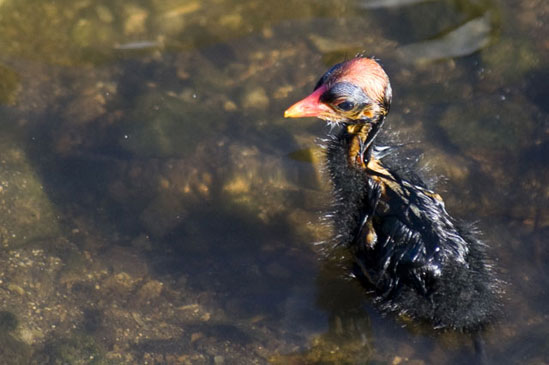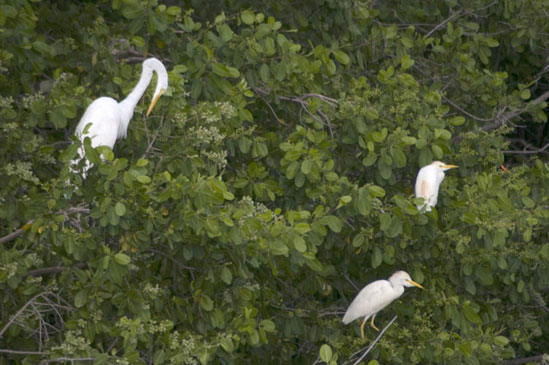Birds
Over 100 species of birds have been observed on Saint Martin, including approximately 40 breeding residents. The remainder are either seasonally migrant visitors or the occasional vagrant. Saint Martin has no endemic species of bird, but it does have two species and six subspecies that are endemic to the Lesser Antilles.
The relative paucity of species is attributed to the small size of the island, extensive habitat destruction and, for some species, hunting. Hurricanes may also have a severe impact, particularly on species that are already stressed by human activity.
This section of the guide is not comprehensive, but does include the majority of commonly seen birds and those which are endemic to this part of the Caribbean. The species that follow are grouped by type, which often serves as an indication of where they are most commonly found, from the seabirds patrolling the offshore waters to waterfowl in the salt ponds and the terrestrial species occupying a variety of inland habitats.

The common ground dove (Columbigallina passerina nigrirostris) is much smaller than the other doves on the island and unlike some of the other doves it is not typically found in urban environments, preferring fields and scrubland.
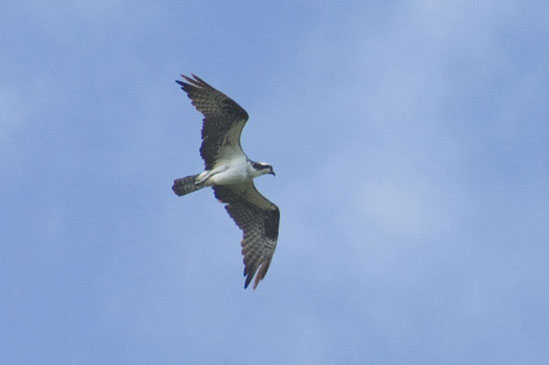
The osprey (Pandion haliaetus) is one of many non-breeding species which may be seen either seasonally or only very rarely. These visitors make up the majority of bird species documented on the island.
Seabirds
Seabirds include a variety of birds from several orders that are adapted to life at sea. They may either be coastal, or spend much of their time on the open ocean. Their primary diet consists of fish and other marine life. The majority of seabirds nest in colonies, and suitable nesting sites are crucial to their survival.
The high level of human activity and development, coupled with egg-eating predators such as the rat and mongoose, have resulted in decreased seabird nesting activity on St. Martin. A number of small offshore islets, however, remain important nesting sites for many seabirds.
These islets include Creole Rock, Caye Chateau, Pelican Key, Molly Beday and Hen and Chickens, all of which are known nesting sites for various species of seabird. For the most part, these are very small rocky formations with little vegetation. Larger satellite islands, such as Tintamarre, Pinel and Caye Verte also serve as nesting sites, but unfortunately are populated by rats. On the mainland, relatively isolated seaside cliffs serve as nesting sites for some species like the tropicbirds.
Although nesting populations of most seabirds have declined in St. Martin as they have in the rest of the world, the presence of many active nesting sites, particularly on isolated islets, has given some researchers reason to consider it one of the more important seabird nesting sites in the Caribbean.
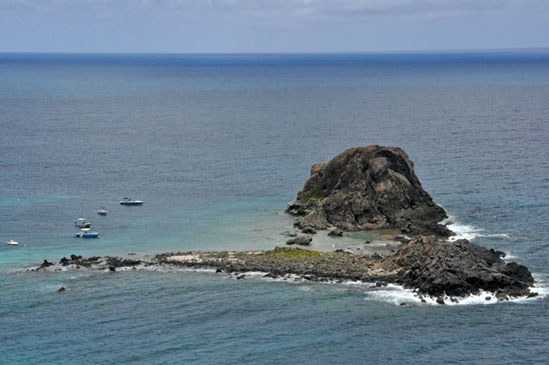
Small offshore rocks and islets like Rocher Creole (Creole Rock) are relatively free from human disturbance and introduced predators, making them important nesting areas for seabirds.
Brown Booby (Sula leucogaster)
The brown booby is a large seabird that may nest on isolated islets in the area. It is a member of the gannet family (Sulidae). They may be seen around the island throughout the year, but are generally less common than the magnificent frigatebird and brown pelican. Most often, they are seen fishing in waters near the coast or roosting along rocky shorelines.
Building exposed nests on the ground, this species is highly vulnerable to predation by introduced species such as the rat.
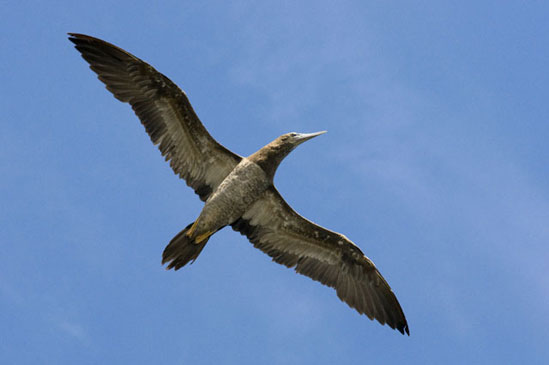
An immature brown booby in flight. When it matures, the light brown area on the underside of the body and wings will turn white, while the darker brown areas will remain dark brown.
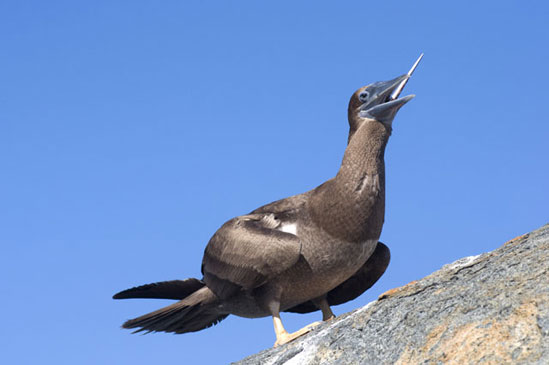
This juvenile brown booby has eaten a needle-nosed fish that it is unable to swallow. It was easily approached because its large meal made it unable or unwilling to fly.
Brown Pelican (Pelecanus occidentalis occidentalis)
The brown pelican is easily identified by its ungainly but endearing shape. The largest seabird on the island, it is typically seen fishing near shore alone. There is known to be a nesting colony on the appropriately-named Pelican Key on the Dutch side of the island. Other nesting colonies have also been noted on Green Cay on the French side, and Molly Beday. The brown pelican is found on both coasts in North and South America, but the subspecies occidentalis is limited to the Caribbean.
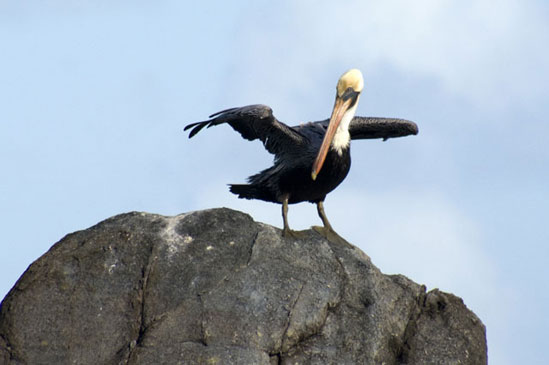
Adult brown pelicans have a white head and neck, although the top of the head may be yellowish or tan. Between fishing trips, they roost on rocks to dry their wings.
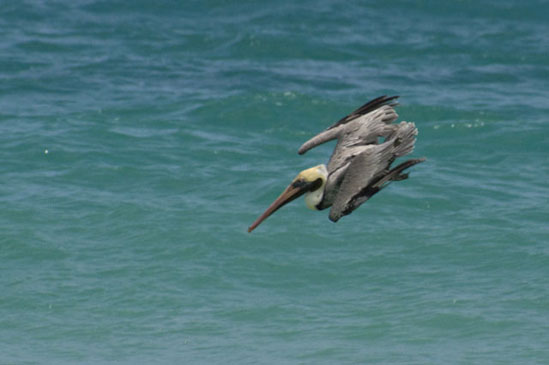
This brown pelican is diving for fish. Unlike some seabirds, they dive directly into the water rather than trying to catch fish at the surface.
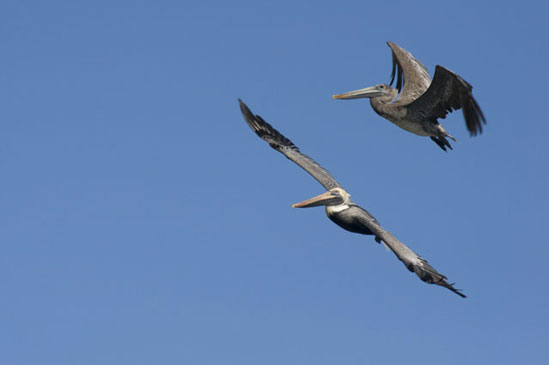
In this pair of flying pelicans the all-brown juvenile is above the adult. Although often seen alone or in pairs, on occasion groups of a dozen or more may be seen fishing together.
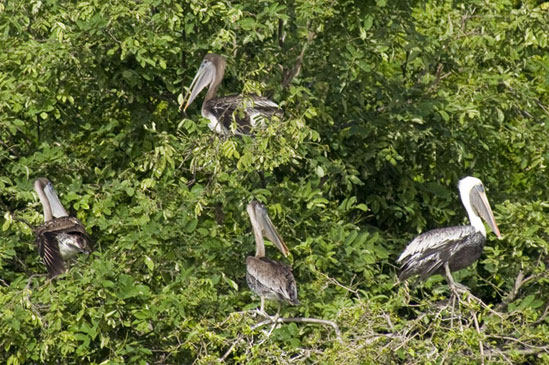
In the trees near Happy Bay large groups of pelicans roost in the evening. The friend who pointed this out to me had first discovered this roosting area decades ago.
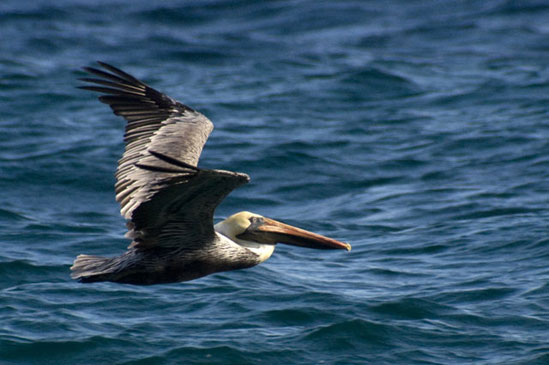
The brown pelican is a strong flyer, although take-off from the water is difficult. They must first expel any water from their gullet, while retaining any fish they have caught. They then take flight with much energetic flapping.
Laughing Gull (Larus atricilla)
The laughing gull is very common during the summer months, when it nests on Pelican Key and probably in other locations. Large flocks can be seen in tidal areas and scavenging near popular beaches. Like many gulls, juveniles are gray in color and lack the distinctive markings of the adult. During the winter months they are much less common on the island.
In addition to coastal areas, these gulls may be seen at the various salt ponds as well as inland scavenging locations such as the local dump. A relatively poor hunter, they may be seen landing on or near pelicans in an attempt to steal food from their beaks.
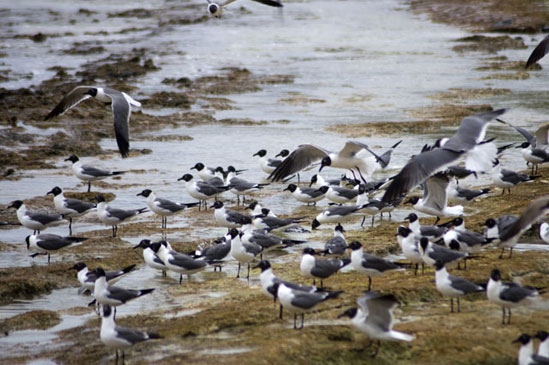
A large group of laughing gulls searches for food in a tidal flat near Grande Caye. Even larger groups may be seen scavenging at the nearby dump.
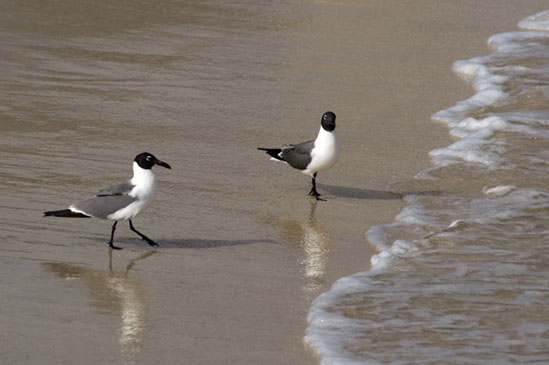
The laughing gull could be mistaken for a similarly-colored tern, but the whole head is black, not just the crown, and the back is generally a darker gray.
Sandwich Tern (Sterna sandwicensis) and Royal tern (Sterna maxima)
There are a number of tern (family Sternidae) species seen on the island, including several which breed here. Most are predominantly white with some dark markings and all are superb, graceful fliers. The breeding species include the sooty tern (Sterna fuscata), least tern (Sternula antillarum antillarum), roseate tern (Sterna dougallii), bridled tern (Sterna anaethetus) and royal tern. The common tern (Sterna hirundo) and sandwich tern are seasonal migrants that do not breed here.
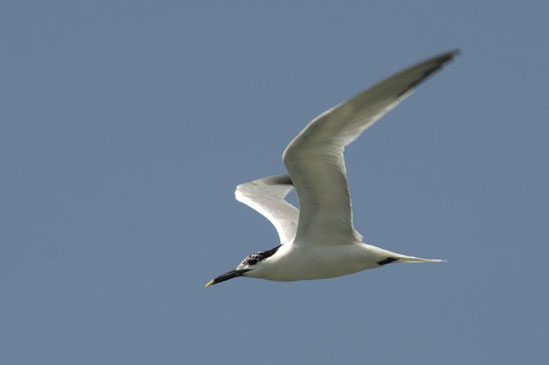
The sandwich tern is a summer visitor to the island and can be identified by its long, white-tipped, black bill.
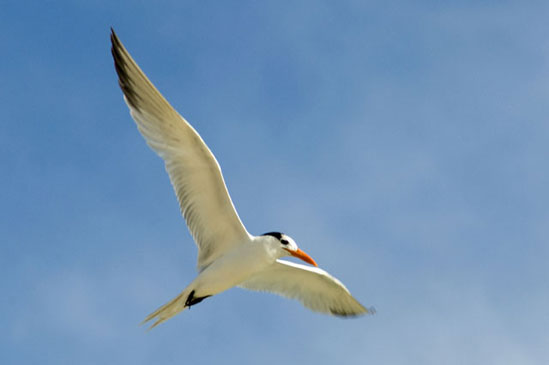
The beak of the royal tern is entirely orange yellow, but it is otherwise quite similar to several other tern species seen on the island.
Magnificent FrigateBird (Fregata magnificens)
The magnificent frigatebird is the second-largest seabird on the island and is most frequently seen circling high over the water. Often large groups circle near choice locations, and they may be seen stealing food from smaller birds, particularly the laughing gull.
These birds are seen year-round, and may breed in mangrove woodlands on the island, but no nesting colonies are currently identified. In fact, there are few known nesting sites in the Caribbean, perhaps due to the practice of draining and clearing mangrove wetlands for development. Locally, this bird is often referred to as the scissorsbird or man o’war.
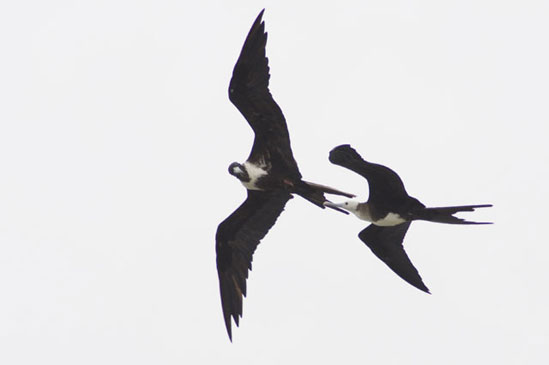
A female (black head) and juvenile (white head) engage in aerial acrobatics near the beach at Grande Caye. Their distinctive forked tails are clearly visible.
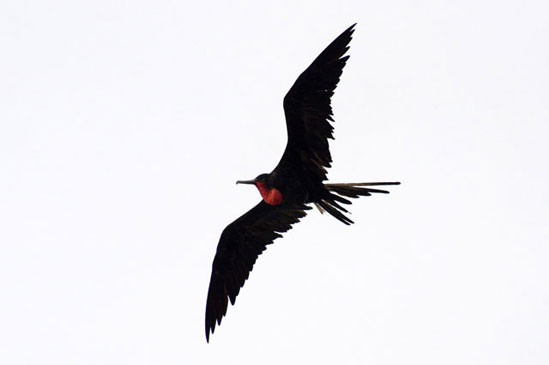
The male magnificent frigatebird has a bright red, inflatable throat pouch that is used in courtship. Clearly visible in this photo, but not totally inflated, it is normally only slightly visible, if at all.
Red-billed Tropicbird (Phaeton aethereus mesonauta)
I most frequently see this bird near the offshore island of Tintamarre, where I believe it nests. Other possible nesting locations include seaside cliffs on the main island, as well as uninhabited offshore rocks like Creole Rock and Molly Beday. The white-tailed tropicbird (Phaethon lepturus) is very similar in appearance and is also known to nest in St. Martin.
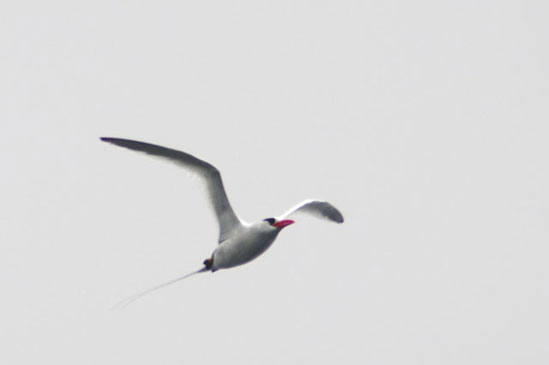
Tropicbirds may easily be distinguished by their very long tail feathers, which may actually be longer than their body.
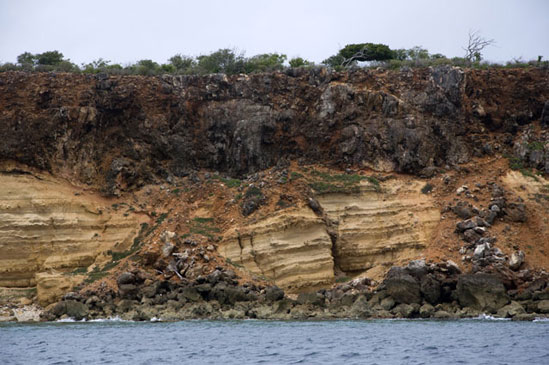
It is highly likely that tropicbirds are nesting in the relatively inaccessible seaside cliffs of Tintamarre, St. Martin’s largest satellite island.
Egrets and Herons
The family Ardeidae includes egrets and herons, elongated, carnivorous wading birds that often live and feed in wetland areas. Most species are at least somewhat migratory, and the population of several species on St. Martin has considerable seasonal variation.
The best place to observe these birds is in and around the many salt ponds and mangrove woodlands on the island. In addition to the species featured here, the great blue heron (Ardea herodias) is at least an occasional visitor to the island.
Snowy Egret (Egretta thula)
The snowy egret is a smallish, white egret with whispy plumage on its head and tail. It can be identified by its black (adult) or yellow and black (immature) legs with yellow feet and black bill. It primarily frequents salt pond and mangrove wetlands. Although it is not thought to breed on most of the Lesser Antilles, it does breed on St. Martin.
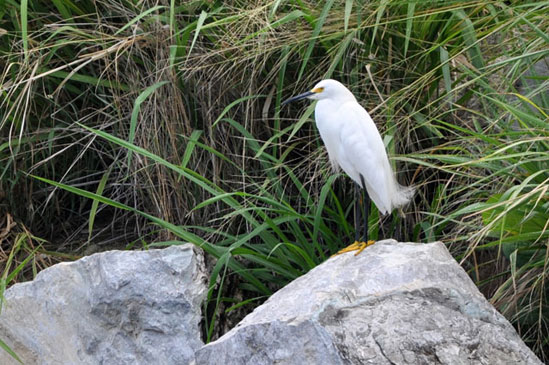
Bright yellow feet at the end of black legs are indicative of this egret. The wispy tail feathers can also be seen in this photo.
Great Egret (Egretta gularis)
The great egret is quite large and is found in the various salt ponds on the island where it fishes. In the evening, I have seen them calling loudly from hillsides near salt ponds. This species typically breeds in trees near wetlands, making the local mangrove forests a potential breeding location, although it is unclear if breeds on the island.
I have seen the closely-related great blue heron (Ardea herodias) on one occasion, but in the dark color phase which could not be mistaken for the great egret.
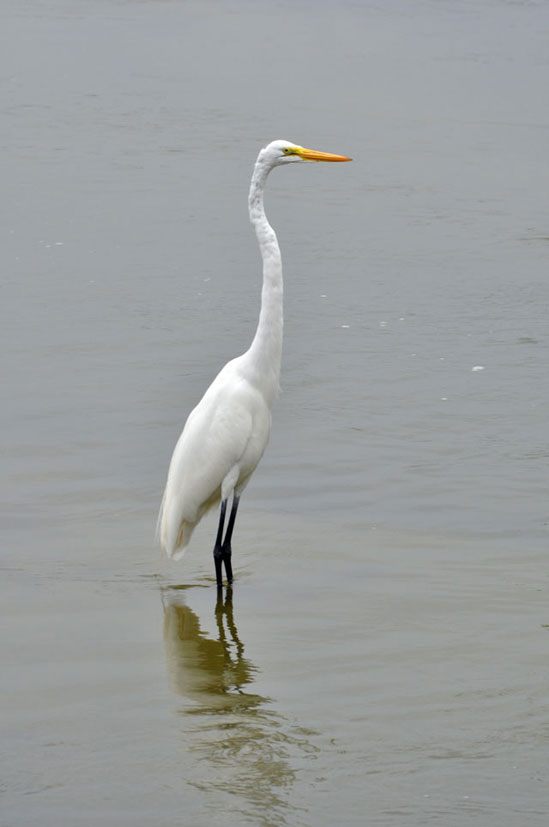
A yellow bill, black legs and large size identify the great egret. The great blue heron (Ardea heriodias) in its white phase is similar, but with gray legs and red-brown thigh plumage, and I have not seen it on the island in that color.
Cattle Egret (Bubulcus ibis)
The cattle egret is an exceedingly common year-round resident of the island. As its name indicates, it is often seen in pastures near cattle, feeding on insects and other small animals that are disturbed by the cattle. Studies have shown that it is several times more successful at hunting when near a large animal than it is when alone.
In the evening, cattle egrets roost primarily in mangroves, often in large groups of a dozen or more individuals. They also breed in colonies in wetland areas.
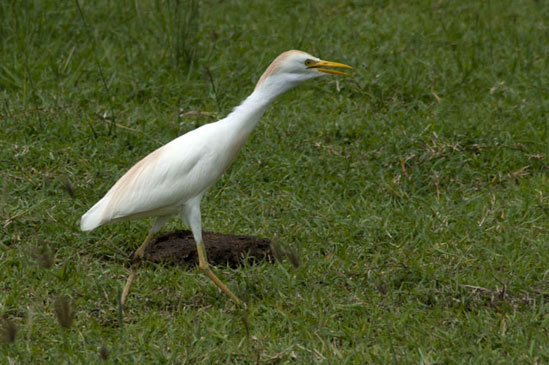
Breeding adults sport patches of orangish-tan on their head, chest and backs. Non-breeding adults are entirely white. They can be distinguished from other egrets and herons by their yellow legs.
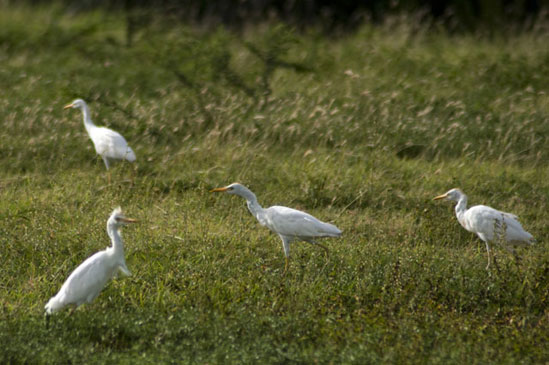
Cattle egrets are generally gregarious and are frequently seen in fields. The similarly colored snowy egret is typically seen alone.
Green Heron (Butorides virescens)
The green heron is a small, nocturnal heron that breeds on St. Martin. Like other herons, it is typically seen near salt ponds and mangrove wetlands, but it also prowls near the beach at night.
The diet of the green heron is primarily small fish, frogs and invertebrates. They are known to drop insects or other small objects into the water to attract fish. This opportunistic feeder is also thought to eat bird eggs, including those of the bananaquit, giving it a bad reputation on the island. This species breeds on Saint Martin, primarily in mangrove wetlands. Locally it is referred to as the night heron or tick picker.
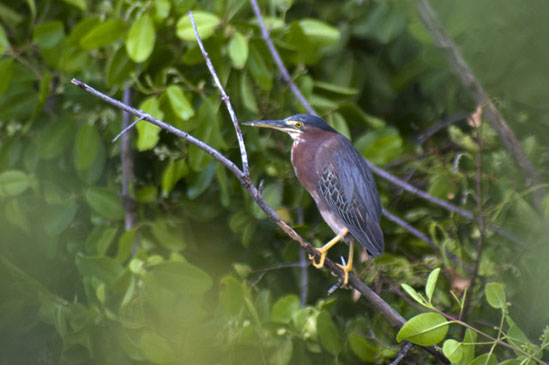
The green heron is not actually green. It is dark above with brown sides and has yellow legs. There is a distinctive yellow-green stripe from the eye to the beak and a brown and white streaked neck and chest.
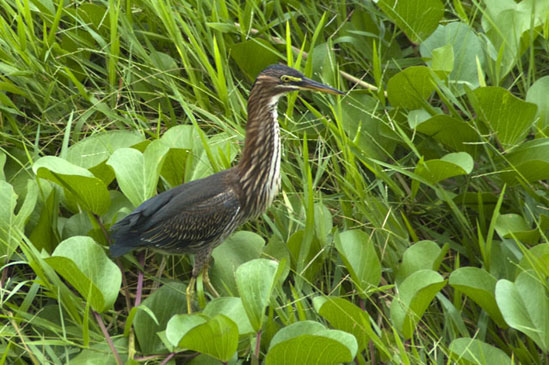
Juvenile green herons have a streaked neck and breast. The top of the head is not as dark, nor is the back.
Yellow-crowned Night Heron (Nyctanassa violacea)
The yellow-crowned night heron is larger and stockier, and can be seen occasionally during the day, although it is also primarily nocturnal. It feeds primarily on fish, frogs and invertebrates.
This species tends to breed in colonies, making nests in trees. There is one such colony in the forested northeastern point of Pinel Islet just off the coast of Saint Martin.
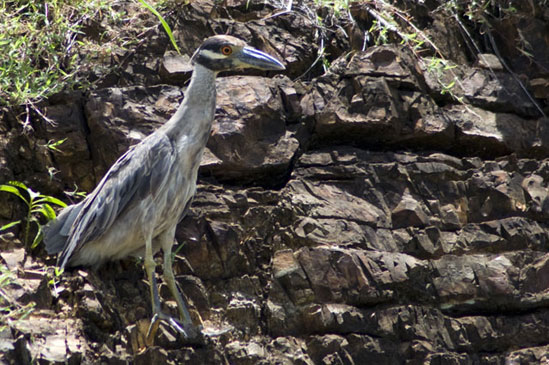
The yellow-crowned night heron has a large red eye and a thick bill. It has a yellow-tan crown that extends behind its head and a white band below the eye.
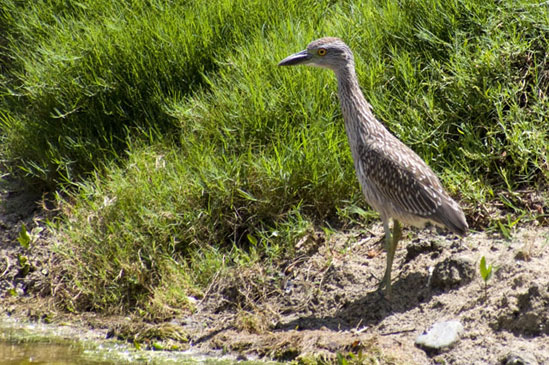
Immature yellow-crowned night herons are a mottled brown color, but can easily be identified by their stocky build and thick beak.
Wading Birds
There is a large variety of wading birds, including species that are primarily found on the beach and in rocky tidal zones, as well as those who prefer salt ponds, mud flats and mangrove wetlands. Many of these species are non-breeding migrants that are only found during certain times of year, other species may reside here year-round and breed on the island. On the island, wading birds in general are typically referred to as pond birds.
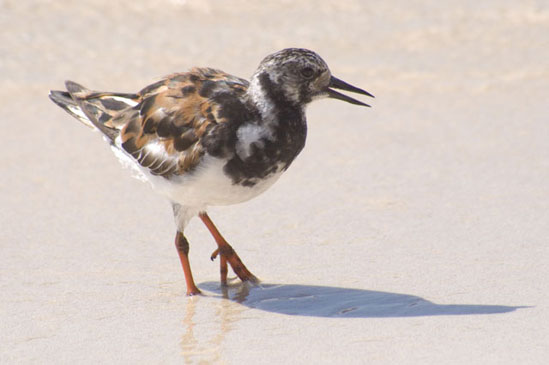
The ruddy turnstone (Arenaria interpres) is a small wader sometimes seen on beaches or rocky shores. It can be identified by its facial markings and red legs.
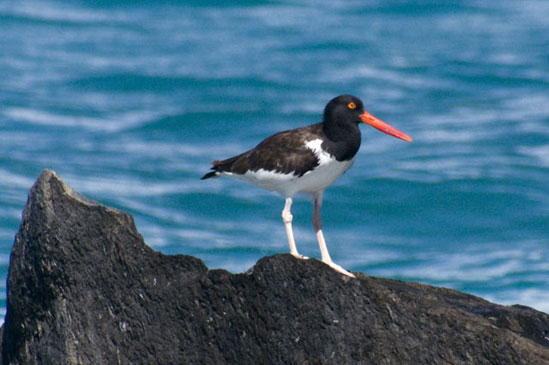
The American oystercatcher (Haematopus palliatus) is a large wading bird seen in tidal areas. It is easily identified by its long, thick, red bill, black head and neck and pink legs.
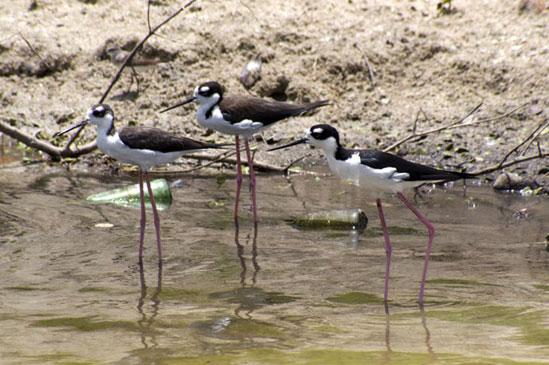
The black-necked stilt (Himantopus mexicanus) is a tall salt pond wader with pink legs, a long black bill and distinct black and white markings. When approached, they make continuous warning calls.
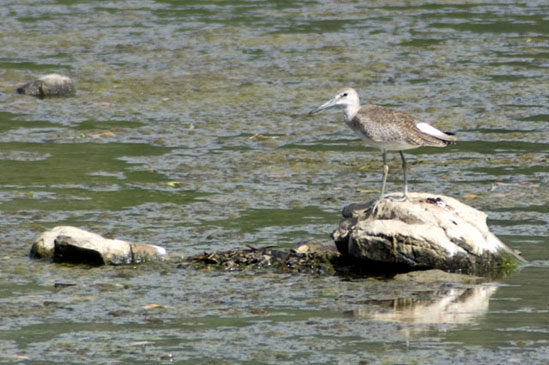
The willet (Catoptrophorus semipalmatus) is gray brown and can be identified by its thick bill and gray legs.
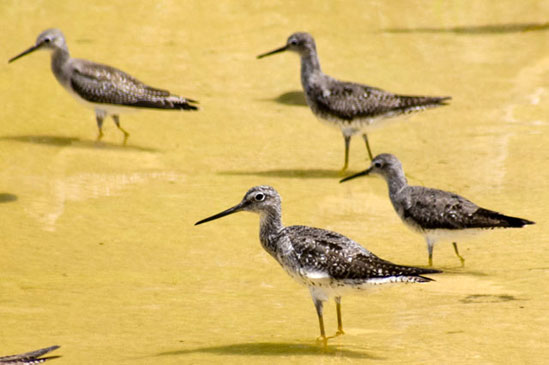
The greater yellowlegs (Tringa melanoleuca) has yellow legs, of course. It also is larger and has a longer bill than the lesser yellowlegs (T. flavipes). Both may be seen in wetlands from August to October.
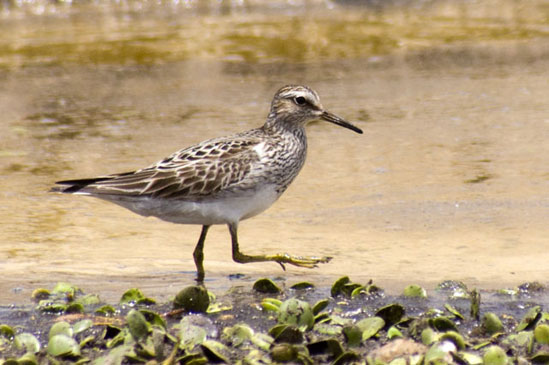
The least sandpiper (Calidris minutilla) is the smallest sandpiper on the island, and can be distinguished from its very similar cousins by its bright yellow legs.
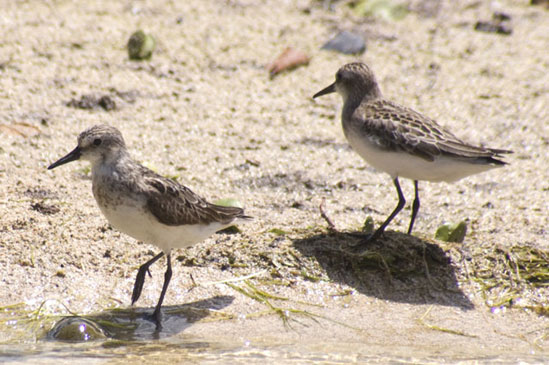
The semipalmated sandpiper (Calidris pusilla) is often seen in flocks near ponds from August through October. A similar species, the western sandpiper (C. mauri), has a longer bill and is slightly larger, but otherwise looks very similar.
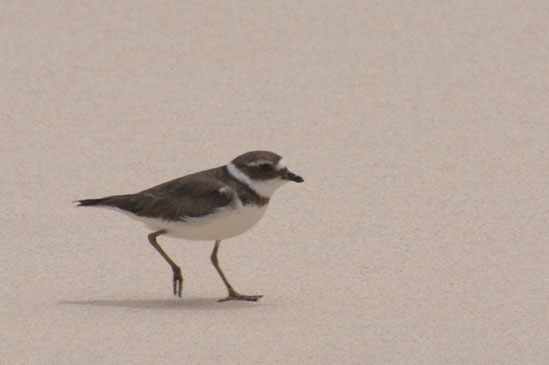
The semipalmated plover (Charadrius semipalmatus) is the only common plover on the island and is seen here in non-breeding coloration. Wilson’s plover (C. wilsonia) and the snowy plover (C. alexandrinus) may also be occasional residents or visitors.
Killdeer (Charadrius vociferus)
The killdeer is a common breeding resident of the island that is found in wet fields, often near puddles or other wet damp areas. They nest on the ground, and adults often pretend to be injured while calling loudly in order to attract attention and lure potential predators away from their nest. When approached, chicks typically attempt to flee on foot. If that fails, they hide, often very poorly.
The killdeer is a type of plover, and is related to the wading birds found on the island, although it generally is found in open fields rather than wetlands.
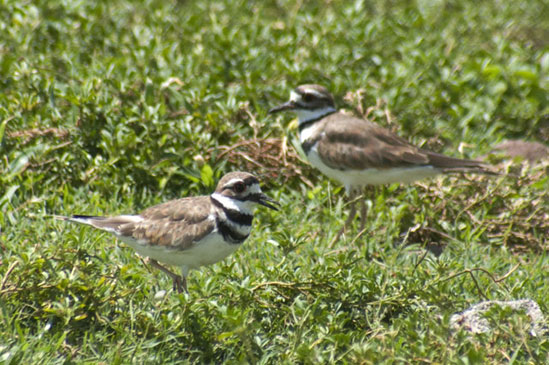
The adult killdeer has two black bands on its breast and is larger than the various plovers that may be seen on the island. It is quite similar to its relatives in general coloration and facial markings.
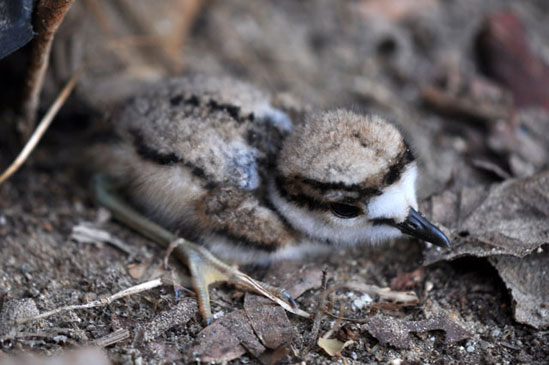
A killdeer chick sports a dark headband and tries to hide when approached.
Waterfowl
The waterfowl of St. Martin includes a variety of ducks as well as several related species. While some nest locally, particularly during the summer months, others are migrants who are merely passing through. The preservation of the many salt ponds on the island is crucial to the continued presence of these species. Ducks and geese are members of the family Anatidae, while the coots and the moorhen are members of the family Rallidae, which also includes rails.
The muscovy duck (Cairina moschata) is a common domestic species on the island. They are very large, usually black and white in color and have warty red faces.
White-cheeked Pintail (Anas bahamensis)
This species is considered rare in the Lesser Antilles, but may be relatively more common in St. Martin due to the presence of a large number of salt ponds.
Also known as the Bahama pintail, these ducks may be seen in pairs or in larger groups, primarily in the salt ponds of the island. The sexes are quite similar in appearance. They feed on plant matter and small animals by dabbling on the surface.
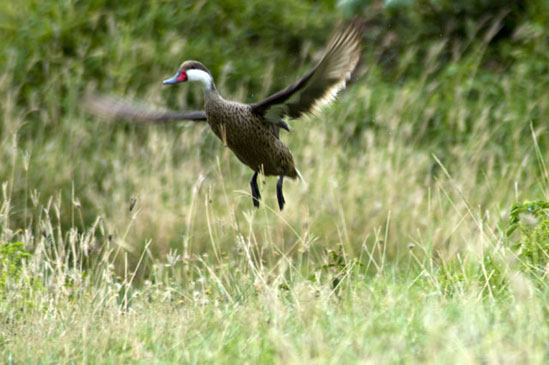
A white-cheeked pintail takes flight from a field bordering a salt pond. The white cheek and red area of the bill make this species easy to identify, even from a distance.
Ruddy Duck (Oxyura jamaicensis)
The ruddy duck is another species thought to be rare in the Lesser Antilles, but pairs are not difficult to find in St. Martin. It seems probable that many waterfowl are generally more common here than on neighboring islands due to the large number of salt ponds.
The ruddy duck may also be seen in mixed groups with the white-cheeked pintail, sometimes numbering a dozen or more. They dive frequently when feeding, and their diet consists of both plant material and various invertebrates.
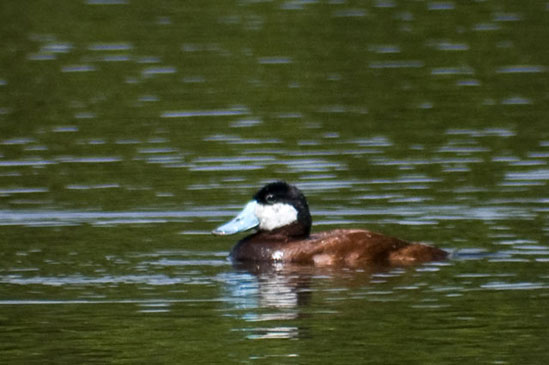
The male ruddy duck has a distinctive blue bill, particularly during the breeding season. There is also a distinct depression on the back of the head.
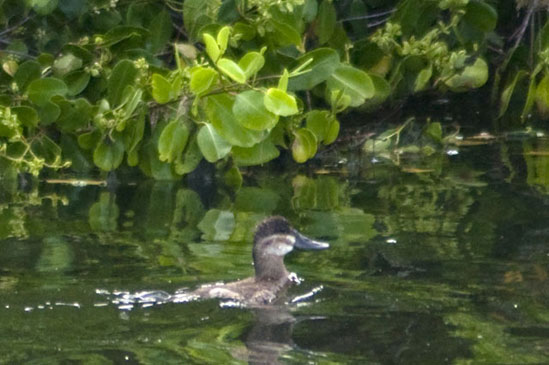
The female ruddy duck is fairly nondescript, but has a defined brown line through the light patch on its cheek. It is, of course, much easier to identify when traveling with its mate.
Common Moorhen (Gallinula chloropus)
This common, year-round resident is locally called the water chicken because of its chicken-like, unwebbed feet. It is seen in and around the salt ponds, nesting in the summer in low hanging mangrove branches on the water. Moorhen chicks are fuzzy and black with red beaks and a slightly balding head. Immature fledglings are typically brown with a dark beak.
Common moorhens, more than other waterfowl, seem to be quite comfortable around humans. They are commonly seen feeding and even nesting near human habitations and well-trafficked areas.
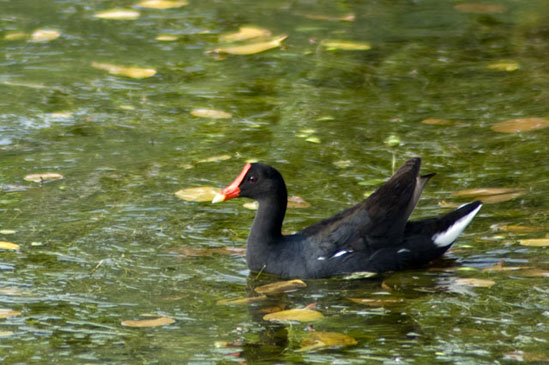
Both sexes of the common moorhen are similar in appearance and easily identified by their yellow-tipped red beak, which extends up to the forehead.
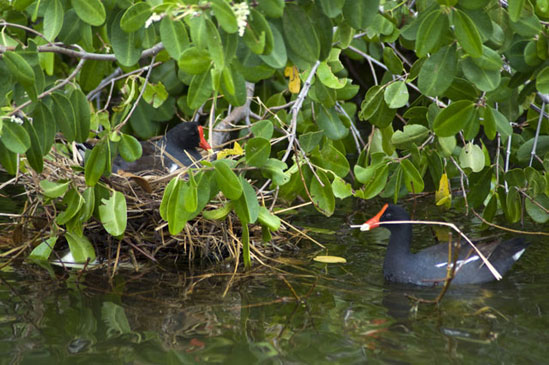
A pair of common moorhens building their nest in the canal that seasonally connects the Grand Case airport salt pond to the ocean.
American Coot (Fulica americana) and Caribbean Coot (Fulica caribaea)
These two coots are both found on the island, typically during the summer months. It is likely that they breed in the wetlands near salt ponds. Very similar in appearance, the Caribbean coot’s white bill extends into a frontal shield to the top of its head and lacks red knobs at the top. Coot chicks are similar to those of the common moorhen, dark and baldish, but with additional orange plumes around the neck. Immature fledglings are gray in color, with a lighter underside.
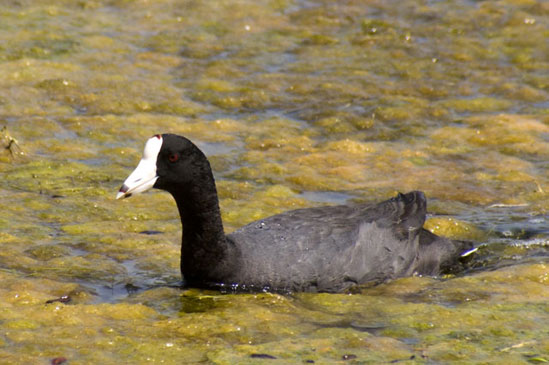
The American coot can be identified by the red knobs at the top of the frontal shield of the bill. It is otherwise very similar to the Caribbean coot.
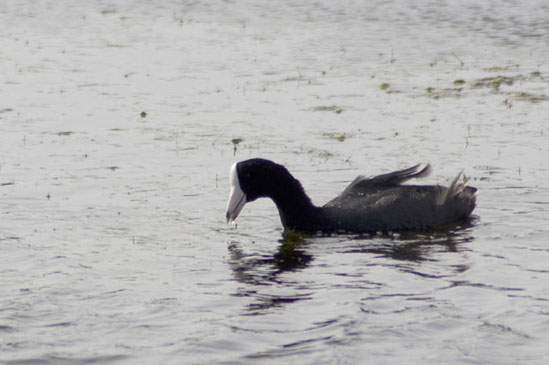
The Caribbean coot has a white shield extending from the bill to the crown of the head and does not have red knobs at the top. From a distance, the two species may be impossible to tell apart.
Terrestrial Birds
Although the diversity of terrestrial birds on St. Martin is not particularly great, there are representatives of at least four orders. There are no island endemics, but two species and six subspecies are endemic to the Lesser Antilles as a whole, all of which are featured in this section. There are a number of nesting species, as well as migrant and vagrant visitors that appear seasonally.
Habitat loss and introduced predators have reduced overall bird populations on the island. Hurricanes temporarily reduce bird populations by disrupting food supplies and destroying nests. The impact of natural disasters is exacerbated by human-caused stresses, making it more difficult for populations to survive and recover.
American Kestrel (Falco sparverius caribaearum)
The American kestrel is a small falcon that is common throughout much of the Americas. It is probably the only raptor breeding on the island, and definitely the most commonly seen.
Also known as the sparrow hawk, and locally as the killy-killy, these birds may be identified by their distinctive facial markings. The sexes are somewhat different in coloration. Both are predominantly orange-brown on their backs, but the male has blue-gray wings. The breast of the female is off-white with tan streaks, while that of the male is typically orangish-tan with dark spots.
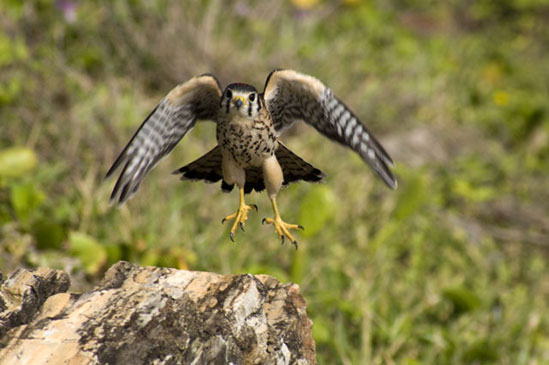
The male American kestrel has a black spots on the breast, rather than brown streaks like the female. There are several distinct subspecies present in the Caribbean.
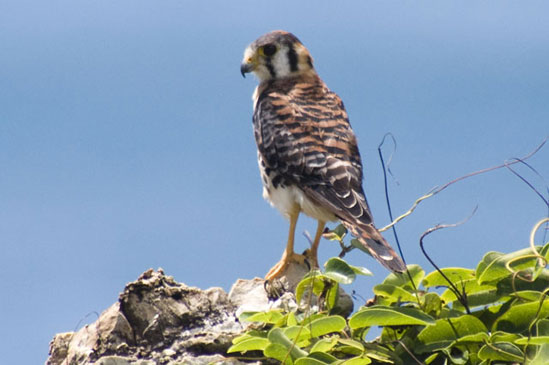
The male American kestrel has blue-gray wings and crown, with a reddish-brown back. Two large black spots can also be seen on the back of the head.
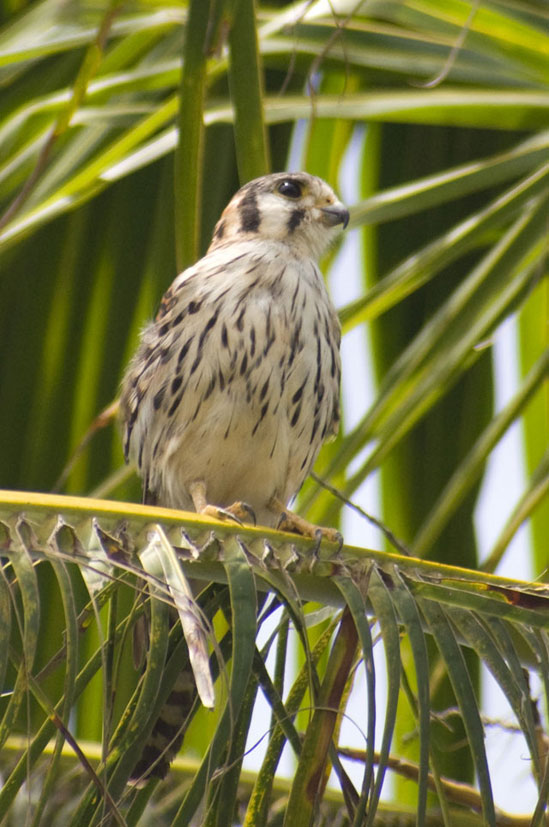
This female American kestrel scans the Grand Case cemetery for potential prey from a perch high on a nearby palm tree. These small birds of prey can be found in a variety of habitats in all parts of the island.
Hummingbirds
From the family Trochilidae, hummingbirds are typically very small, and have amazing flying abilities, including the ability to hover and fly backwards.
There are probably only two species of hummingbird on the island. Both species are endemic to the Lesser Antilles.
A third species that might be present is the purple-throated carib (Eulampis jugularis). Although this hummingbird is found on nearby islands, it seems to prefer higher elevations than St. Martin has to offer.
Antillean Crested Hummingbird (Orthorhyncus cristatus exilios)
The Antillean crested hummingbird is subspecifically endemic to the Lesser Antilles and is generally quite common. It can be identified by the green crest and straight bill and is often seen feeding from flowers in gardens. This species is much smaller than the green-throated carib.
It is thought that hurricanes have a serious impact on hummingbird populations by causing nectar shortages, which are serious for birds with such a high metabolism.
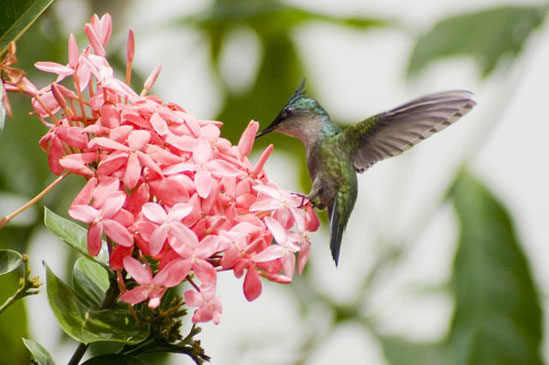
This Antillean crested hummingbird was feeding from flowers just after a hurricane passed. During this time it was easier to see hummingbirds at the few intact flowers in the area.
Green-throated Carib (Sericotes holosericeus holocereus)
The green-throated carib may appear black in flight, but has iridescent green plumage on the throat and head. It can be distinguished from the Antillean crested hummingbird by its lack of a crest as well as its longer, curved beak.
The purple-throated carib (Eulampis jugularis), if it is present on the island, is quite similar in appearance, but can be distinguished by its purple throat.
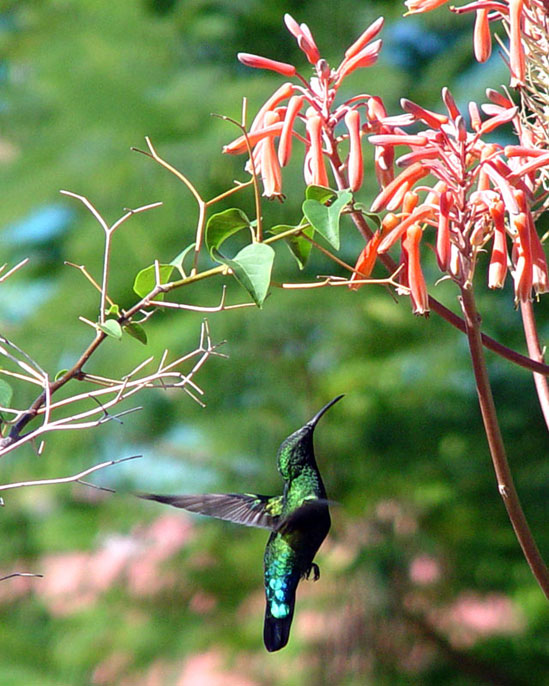
The green-throated carib is an iridescent green in the right light, but also may appear mostly black. It is larger than the Antillean crested hummingbird, with a longer, curved bill. (Photo by M.P.)
Doves and Pigeons
The doves and pigeons, from the family Columbidae, include some of the most common, highly-visible birds on the island. Although many were heavily hunted, a decline in hunting has caused several species to rebound in population. Many of these birds are quite common in urban areas, particularly the zenaida and Eurasian collared doves.
Eurasian Collared Dove (Streptopelia decaocto)
The Eurasian collared dove is an introduced species that has been expanding its range in the Caribbean. It currently seems less common on St. Martin than the similarly-sized zenaida dove, but it is entirely possible this balance will shift in the coming years. It seems to prefer developed areas. It can easily be identified by its light-gray coloration and distinct black and white collar. Locally they are also known as barbie doves.
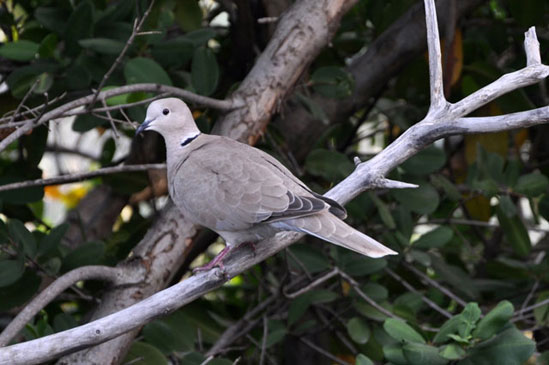
The Eurasian collared dove is similar in size to the zenaida dove, but is a light gray-brown with a distinct black and white collar around the back of its neck.
Zenaida Dove (Zenaida aurita aurita)
The zenaida dove is quite common on St. Martin, living primarily in open areas such as fields, roadsides and towns. They are also sometimes found inside my apartment. On one occasion I saw two individuals that seemed to be fighting, both employing a strange stance with one wing raised.
The subspecies aurita is endemic to the Lesser Antilles. The white tips of the secondary wing feathers distinguish this species from the eared dove and mourning dove. These similar species are not known on St. Martin, but do have expanding ranges in the Caribbean.
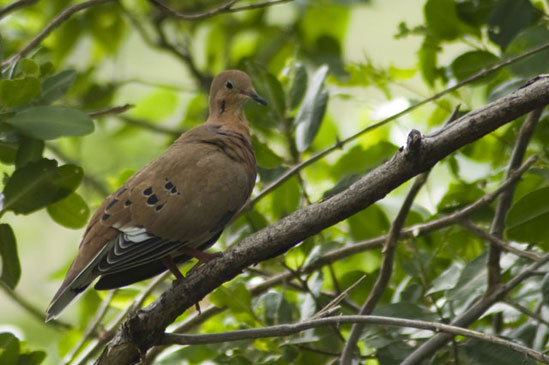
The zenaida dove can easily be identified by its orangish-brown color, black spots and white wing band. It also has a black crescent mark on its neck.
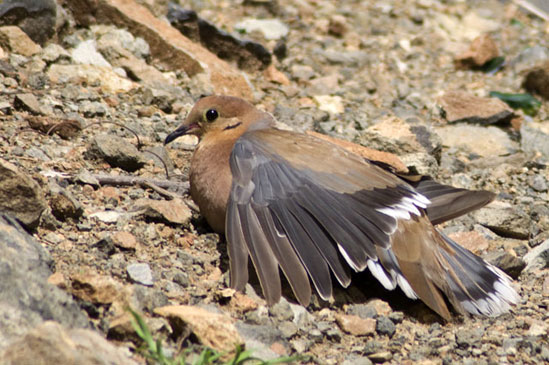
This individual was foraging on the ground when I approached, and adopted a strange stance, perhaps in an attempt to camouflage itself.
Common Ground Dove (Columbigallina passerina nigrirostris)
The common ground dove is about half the size of the zenaida and Eurasian collared doves, and is found primarily in open areas away from human development. From a distance they appear to be a nondescript gray-brown, but in flight they reveal bright, brick red wing feathers. When seen up close, their head has a wonderful pearly sheen.
The subspecies nigrirostris is endemic to the Lesser Antilles, and it thankfully seems quite common on the island today.
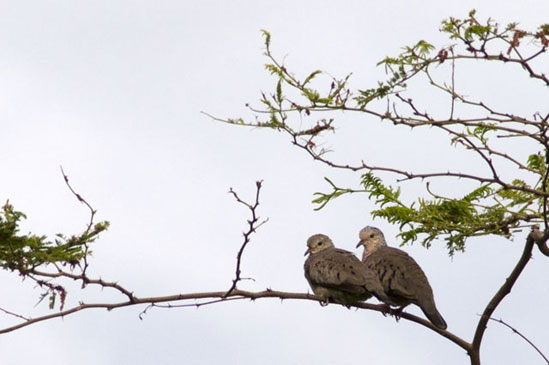
Common ground doves are indeed usually seen foraging on the ground, but will also roost in trees. I have often seen them in pairs or small groups.
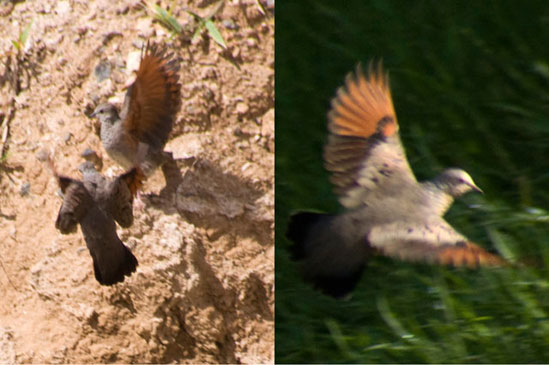
The bright red wing feathers of the common ground dove are seen during flight. I have also witnessed doves spreading their wings while on the ground, perhaps as part of a courtship ritual.
Scaly-naped Pigeon (Columba squamosa)
One of several species that was hunted to near extinction on the island, this bird may be seen occasionally, primarily in remote areas. It is easily identified by its long neck and red patch around the eye. The neck feathers, which are a reflective red in the right light, have a scaly appearance which gives this bird its name.
This bird is endemic to the Caribbean, ranging from Cuba to the various offshore islands of Venezuela. On Saint Martin, it is often referred to as the copper neck or blue pigeon. It typically travels in pairs, while groups of four are usually a couple with their children.
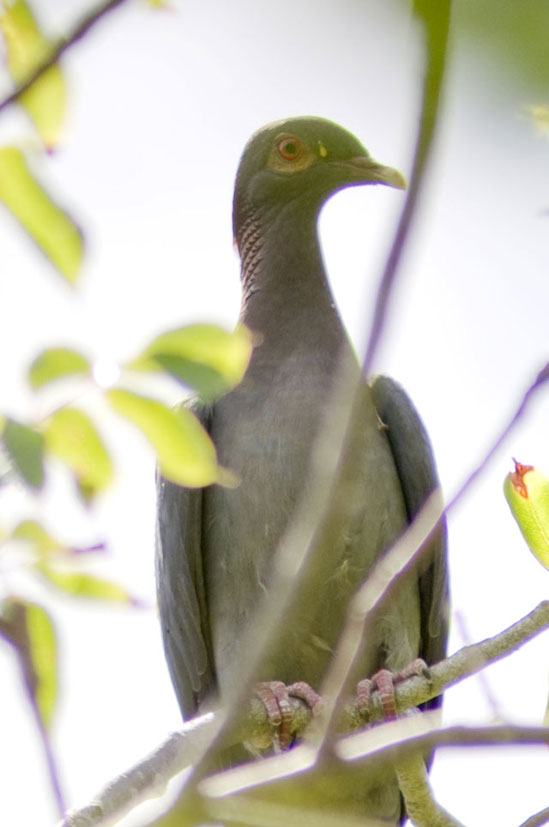
The long, scaly-looking neck and red area around the eye make this relatively uncommon pigeon easy to identify, even from a distance.
Perching Birds
The order Passeriformes includes more than half of all bird species and the majority of perching birds on the island. Generally fairly small, these birds are quite diverse, and include seed-eaters, insectivores and nectar-drinkers that inhabit virtually every habitat on the island.
Also included in this section is one species of cuckoo, from the order Cuculiformes. The cuckoos are closely related to the passerines. Not pictured here is the barn swallow (Hirundo rustica), which is seasonally quite common and may be seen flying near the coast, salt ponds and other areas. It is quite small, has a forked tail and is an agile flyer.
Yellow Warbler (Dendroica petechia bartholemica)
Another subspecies endemic to the northern Lesser Antilles, the yellow warbler, locally known as the goldfinch, does not seem very common on the island and is probably restricted to relatively small areas of scrubland and mangrove forest. The individuals I observed were actually seen at the border between these two habitats. They seemed to spend most of their time hopping from branch to branch inside the crowns of acacias and other trees.
This small bird is yellow with brown streaks on its breast. Immature birds and non-breeding females are generally brown with a faint cast of yellow.
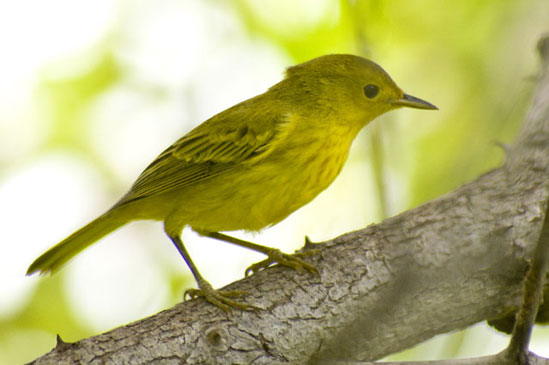
This yellow warbler was seen in a mixed area of acacia bordering a mangrove woodland.
Bananaquit (Coereba flaveola bartholemica)
This subspecies of bananaquit is named after nearby St. Barths and is found only in the northern Lesser Antilles. It is quite common near human habitation and is also called the sucriere or sugar bird due to its love of sugar. It may also be referred to as the yellow breast.
The taxonomy of the bananaquit is uncertain. It is tentatively placed in the family Thraupidae along with the finches of the Galapagos and grassquits, pending more certain classification. In 2010, the International Ornithological Congress also suggested grouping the varieties this into three distinct species.
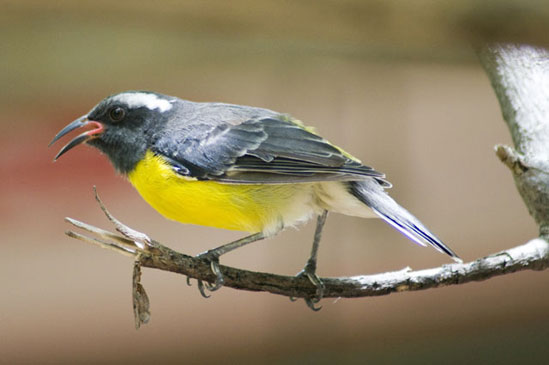
The low, shrubby forest on Pinel island is home to many bananaquits, who also frequent the restaurant bars on the islet to drink simple syrup from unattended bottles.
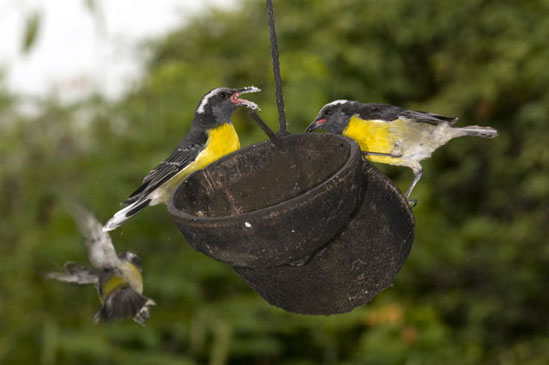
These bananaquit are enjoying sugar from a bird feeder. Their natural food is plant nectar, but their opportunistic feeding habits likely contribute immensely to their success on the island.
Black-faced grassquit (Tiaris bicolor)
This small bird is generally common in the Caribbean and can often be seen in scrubland, open fields and near habitations. While the male is fairly easy to identify, the female may be difficult or impossible to distinguish from the female Lesser Antillean bullfinch.
Primarily a seed eater, it is a tanager, and is thought to be closely related to the finches of the Galapagos that were originally collected by Charles Darwin and were an important inspiration for his theory of evolution by means of natural selection. Along with the Lesser Antillean bullfinch, it is locally known as the chi-chi or sparrow.
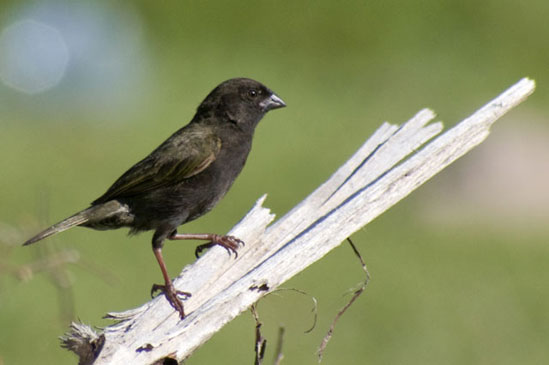
The male black-faced grassquit can be identified by its dark face and chest.
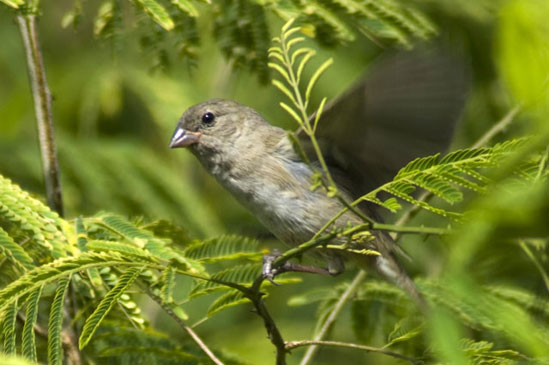
The female and immature black-faced grassquit are brown with no noticeable markings, although a bit of pink skin is usually visible at the base of the beak.
Lesser Antillean Bullfinch (Loxigilla noctis ridgewayi)
The Lesser Antillean bullfinch is another variety that is subspecifically endemic to the northern Lesser Antilles and is primarily seen in open scrubland and near habitations. The male is black with reddish patches on the neck, above the eye and around the butt. The female is a nondescript brown and may easily be mistaken for the female black-faced grassquit (Tiaris bicolor).
The name bullfinch comes from a resemblance to the European bullfinches, but currently these birds are believed to be part of the tanager family (Emberizidae). Locally, it may be referred to as the chi-chi or sparrow.
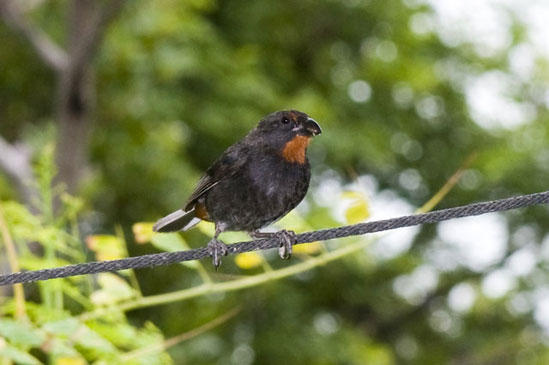
The male is easily identified by its coloration, which is predominantly black with reddish brown patches.
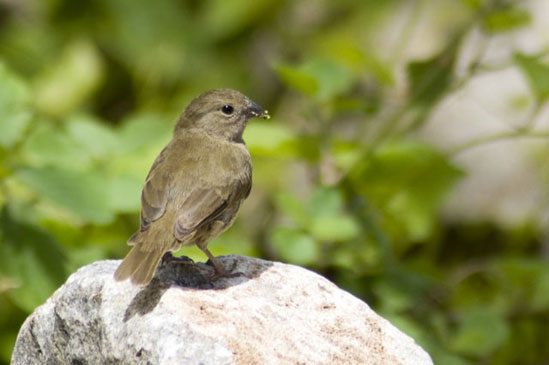
The female is quite difficult to distinguish from the female black-faced grassquit which is also present on the island.
Carib Grackle (Quiscalus lugubris guadeloupensis)
This bird is endemic to the Lesser Antilles at the subspecies level, and has only been reported on St. Martin since the 1970s. Males are all black and look a bit like a small crow, but have bright yellow eyes. Females are brown and relatively nondescript.
When courting, males have a song and dance routine that involves fluffing out their feathers and spreading their wings and tail while calling. They don’t seem particularly common in most areas, but are very common near Mullet Bay and perhaps other preferred locations.
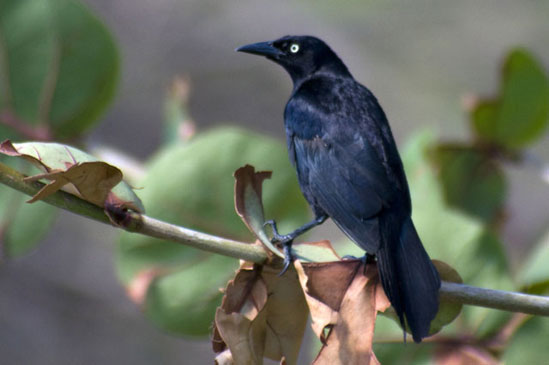
The male carib grackle is a shiny black, with bright eyes. They are slightly smaller than the pearly-eyed thrasher and slightly larger than the gray kingbird.
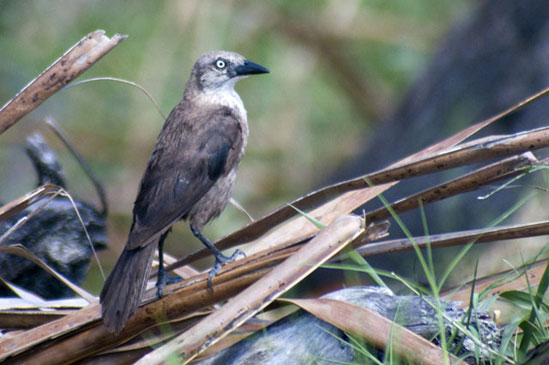
The female carib grackle is slightly smaller and similar in shape to the male, but is brown with a lighter underside. Juveniles resemble the female, but have dark brown eyes.
Pearly-eyed Thrasher (Margarops fuscatus)
This thrasher is relatively common on the island and can often be seen in towns. It has a brown upper side and a white underside streaked with brown. The bill is long and yellow and the eye is a striking pearly white color. I have seen this bird carefully attacking a giant centipede (Scolopendra sp.), repeatedly jabbing it and then quickly jumping into the air to avoid being bitten.
The call of this bird often resembles the slide whistle part from Deee-lite’s Groove Is in the Heart, but faster. The local name for this bird is thrush, pronounced trush.
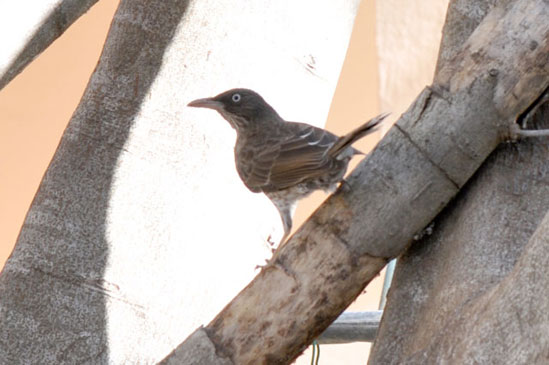
A pearly-eyed thrasher stares back in disdain after I interrupted its attack on a giant centipede.
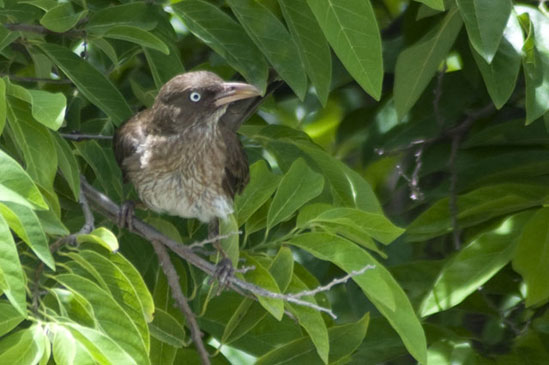
The lighter-colored, longer beak helps distinguish this species from the smaller scaly-breasted thrasher (Allenia fusca), which I have not seen here, but does live on some nearby islands.
Gray Kingbird (Tyrannus dominicensis)
The gray kingbird is a tyrant flycatcher and is quite common on the island. It can be seen both in scrubland and in towns and is identified by its gray head, gray-brown upper side and pale gray underside. Upon close inspection, small “whiskers” may be seen at the base of its bill. A orange stripe down the crown of the head may be present, but usually is not visible. Although there are several similar species in the Caribbean, none of them live on St. Martin. This bird is known locally as the chincherry.
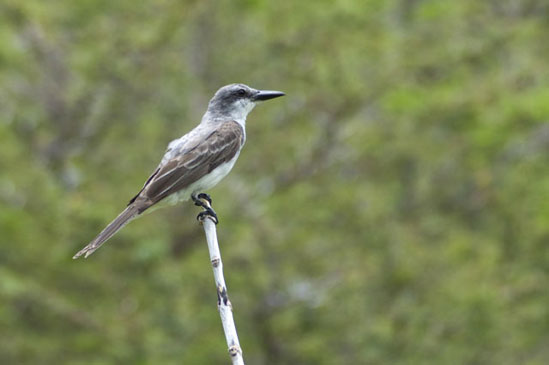
In addition to scrubland areas, the gray kingbird may be seen around human habitation. It is one of the more common birds on the island.
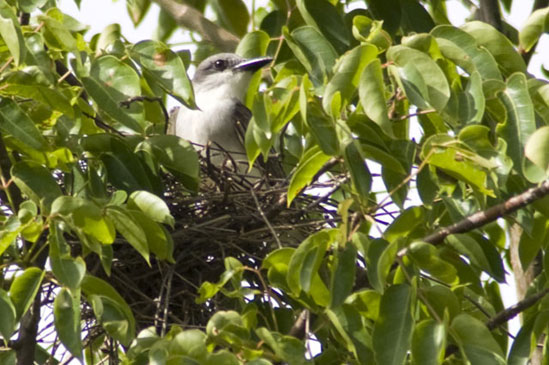
This gray kingbird was seen on its nest high in a tree at the edge of a scrubland area. I have also noticed nests atop telephone poles.
Mangrove cuckoo (Coccyzus minor)
More than any other bird on the island, the mangrove cuckoo seemed quite curious about me. It is fairly large bird with some similarities to the gray kingbird. It has dirty yellow on the underside, primarily near the legs, resembling the northern variant of this species (the southern variant is yellow-orange on the underside from the neck to the tail). Other identifying features include a dark patch from the beak through the eye, and a beak that is black on top and yellow below. The tail feathers are black with white tips, giving the tail a black and white barred appearance. It frequents scrubland and mangrove woodlands.
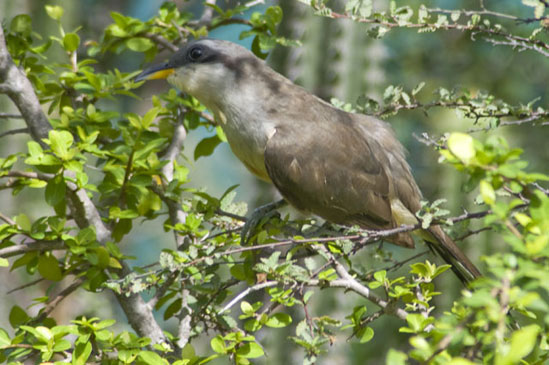
The distinctive beak and dark, Zorro-style mask are clear markers of this species. The yellow underparts are not visible in this photo.
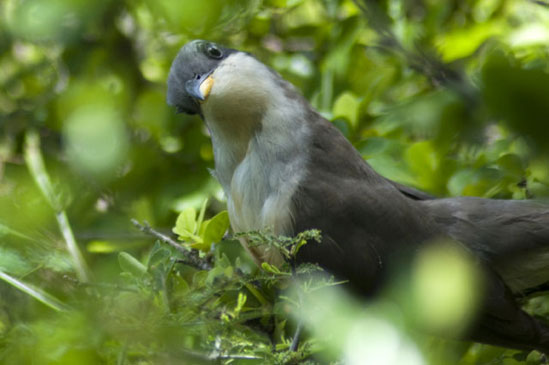
This individual seemed to be quite curious about me. Although it moved several times while I was watching it, it did not fly away. Having not seen it before, I was quite curious about it as well.

